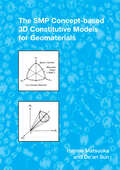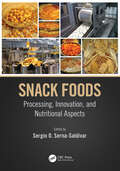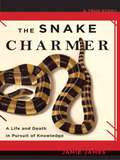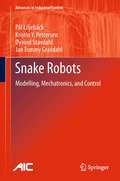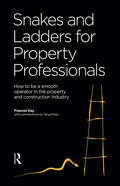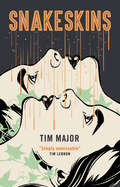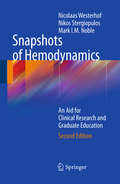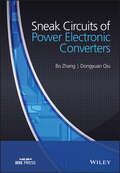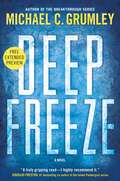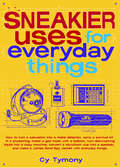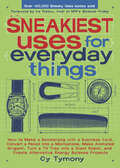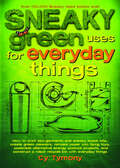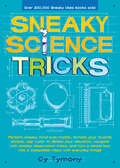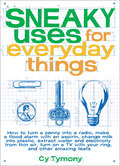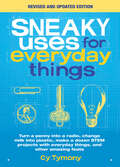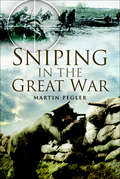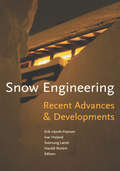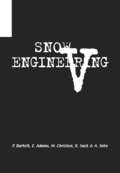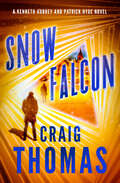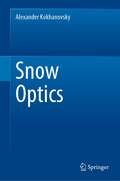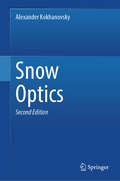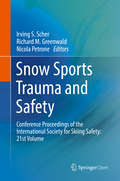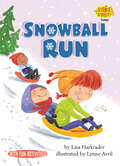- Table View
- List View
The SMP Concept-Based 3D Constitutive Models for Geomaterials
by Hajime MatsuokaThe Cam-Clay model is a fundamental constitutive model in soil mechanics, but is only suitable for normally consolidated clay under triaxial compression stress states. This book introduces the SMP criterion, its integration with the well-known Cam-clay model, and its application to the general eleastoplastic constitutive models for geomaterials like clay, sand and unsaturated soil.
Snack Foods: Processing, Innovation, and Nutritional Aspects
by Sergio O. Serna-SaldivarThe diverse segments of the snack industries that generate close to $520 billion of annual sales are adapting to new consumer´s expectations, especially in terms of convinience, flavor, shelf life, and nutritional and health claims. Snack Foods: Processing, Innovation, and Nutritional Aspects was conceptualized to thoroughly cover practical and scientific aspects related to the chemistry, technology, processing, functionality, quality control, analysis, and nutrition and health implications of the wide array of snacks derived from grains, fruits/vegetables, milk and meat/poultry/seafood. This book focuses on novel topics influencing food product development like innovation, new emerging technologies and the manufacturing of nutritious and health-promoting snacks with a high processing efficiency. The up-to-date chapters provide technical reviews emphasising flavored salty snacks commonly used as finger foods, including popcorn, wheat-based products (crispbreads, pretzels, crackers), lime-cooked maize snacks (tortilla chips and corn chips), extruded items (expanded and half products or pellets), potato chips, peanuts, almonds, tree nuts, and products derived from fruits/vegetables, milk, animal and marine sources. Key Features: Describes traditional and novel processes and unit operatios used for the industrial production of plant and animal-based snacks. Depicts major processes employed for the industrial production of raw materials, oils, flavorings and packaging materials used in snack food operations. Contains relevant and updated information about quality control and nutritional attributes and health implications of snack foods. Includes simple to understand flowcharts, relevant information in tables and recent innovations and trends. Divided into four sections, Snack Foods aims to understand the role of the major unit operations used to process snacks like thermal processes including deep-fat frying, seasoning, packaging and the emerging 3-D printing technology. Moreover, the book covers the processing and characteristics of the most relevant raw materials used in snack operations like cereal-based refined grits, starches and flours, followed by chapters for oils, seasoning formulations and packaging materials. The third and most extensive part of the book is comprised of several chapters which describe the manufacturing and quality control of snacks mentioned above. The fourth section is comprised of two chapters related to the nutritional and nutraceutical and health-promoting properties of all classes of snacks discussed herein.
The Snake Charmer: A Life and Death in Pursuit of Knowledge
by Jamie JamesAlthough it was still too dark to see well, Joe absentmindedly thrust his right hand into the sack to extract the specimen and have a look. Immediately, he winced with pain and yanked out his hand. A tiny black-and-white banded snake, less than ten inches long, was dangling limply from his middle finger, its fangs still sunk into his flesh. In the fall of 2001, deep in the jungle of Burma, a team of scientists is searching for rare snakes. They are led by Dr. Joe Slowinski, at forty already one of the most brilliant biologists of our time. It is the most ambitious scientific expedition ever mounted into this remote region, venturing into the foothills of the Himalayas. The bold undertaking is brought to a dramatic halt by the bite of the many-banded krait, the deadliest serpent in Asia. In the moment he pulled his hand from the specimen bag and saw the krait, Joe knew that his life was in grave and imminent peril. Thus began one of the most remarkable wilderness rescue attempts of modern times, as Joe's teammates kept him alive for thirty hours by mouth-to-mouth respiration, waiting for a rescue that never came. A daredevil obsessed with venomous snakes since his youth, Slowinski was a modern-day adventurer who rose quickly to the top of his field, discovering many previously unidentified snake species in his brief yet exhilarating career. The Snake Charmer is at once brilliant biography and exotic travel literature, blended with an accessible introduction to the bizarre, fascinating-and sometimes controversial-world of snake science. The narrative transports the reader into primeval wilderness, from the Everglades to Peru to Burma, in search of rattlesnakes and boa constrictors, kraits and cobras. Joe Slowinski's career was fast and exciting, his tragic final expedition a pulse-pounding struggle between man and nature. In The Snake Charmer, renowned journalist and author Jamie James captures the life and death of this charismatic, endlessly fascinating man. Exhaustively researched in interviews with Slowinski's colleagues and family, and the author's own trek into the wilds of Burma, this is narrative nonfiction in the tradition of Into the Wild and The Perfect Storm.
Snake Oil: How Fracking's False Promise of Plenty Imperils Our Future
by Richard HeinbergThe rapid spread of hydraulic fracturing ("fracking") has temporarily boosted US natural gas and oil production ... and sparked a massive environmental backlash in communities across the country. The fossil fuel industry is trying to sell fracking as the biggest energy development of the century, with slick promises of American energy independence and benefits to local economies. SNAKE OIL casts a critical eye on the oil-industry hype that has hijacked America's energy conversation. This is the first book to look at fracking from both economic and environmental perspectives, informed by the most thorough analysis of shale gas and oil drilling data ever undertaken. Is fracking the miracle cure-all to our energy ills, or a costly distraction from the necessary work of reducing our fossil fuel dependence?
Snake Robots
by Kristin Y. Pettersen Øyvind Stavdahl Jan Tommy Gravdahl Pål LiljebäckSnake Robots is a novel treatment of theoretical and practical topics related to snake robots: robotic mechanisms designed to move like biological snakes and able to operate in challenging environments in which human presence is either undesirable or impossible. Future applications of such robots include search and rescue, inspection and maintenance, and subsea operations. Locomotion in unstructured environments is a focus for this book. The text targets the disparate muddle of approaches to modelling, development and control of snake robots in current literature, giving a unified presentation of recent research results on snake robot locomotion to increase the reader's basic understanding of these mechanisms and their motion dynamics and clarify the state of the art in the field. The book is a complete treatment of snake robotics, with topics ranging from mathematical modelling techniques, through mechatronic design and implementation, to control design strategies. The development of two snake robots is described and both are used to provide experimental validation of many of the theoretical results. Snake Robots is written in a clear and easily understandable manner which makes the material accessible by specialists in the field and non-experts alike. Numerous illustrative figures and images help readers to visualize the material. The book is particularly useful to new researchers taking on a topic related to snake robots because it provides an extensive overview of the snake robot literature and also represents a suitable starting point for research in this area.
Snakes and Ladders for Property Professionals
by Frances Kaye Tanya RossThis book is for all those seeking to maximise the effectiveness of their professional relationships in order to reach the top of the property or construction industries. It is written to help young professionals at the early stages of their careers increase their understanding of others and to help more experienced practitioners gain additional skills on their way to the top. It guides you through the intricate steps of professional relationship building – internally for positive staff relationships and proactive teams as well as externally for smooth project management, delivery and business development. It contains advice that all ambitious professionals will find helpful: strategies to help you make the most of your strengths and optimise any opportunities that may present themselves. It is generously sprinkled with cases studies, some of which will cover familiar territory, others will act as a useful warning. Anyone choosing a career in the property and construction profession will benefit from reading this book. Whatever your level of seniority, the tips and tactics will help you to spot and avoid those slippery snakes and climb the ladders to the top.
Snakeskins
by Tim MajorAn SF thriller examining the repercussions of rejuvenation and cloning on individuals' sense of identity and on wider society.Caitlin Hext's first shedding ceremony is imminent, but she's far from prepared to produce a Snakeskin clone. When her Skin fails to turn to dust as expected, she must decide whether she wishes the newcomer alive or dead. Worse still, it transpires that the Hext family may be of central importance to the survival of Charmers, a group of people with the inexplicable power to produce duplicates every seven years and, in the process, rejuvenate. In parallel with reporter Gerry Chafik and government aide Russell Handler, Caitlin must prevent the Great British Prosperity Party from establishing a corrupt new world order.Snakeskins is an SF thriller examining the repercussions of rejuvenation and cloning on individuals' sense of identity and on wider society, with the tone of classic John Wyndham stories and the multi-strand storytelling style of modern TV series such as Channel 4's Humans.
Snapshots of Hemodynamics
by Nicolaas Westerhof Nikos Stergiopulos Mark I.M. NobleThis book is written to help clinical and basic researchers, as well as graduate students, in the understanding of hemodynamics. Recent developments in genetics and molecular biology as well as new non-invasive measurement techniques, make it possible to measure and understand the hemodynamics of heart and vessels better than ever before. Hemodynamics make it possible to characterize, in a quantitative way, the function of the heart and the arterial system, thereby producing information about what genetic and molecular processes are of importance for cardiovascular function. The layout of the book provides a short and essential overview of individual topics. It is designed as a quick reference guide and each chapter can stand alone. The chapters are written to define the basic and applied principles of the hemodynamic topic. If more details or broader perspectives are desired, the reader can refer to related chapters to which the text refers, or the textbooks listed in the 'Reference books' section in Appendix 5. Each chapter starts with a 'box' containing a figure and caption that give the basic aspects of each topic. Chapters end with the section, 'Physiological and Clinical Relevance' that puts the information from the chapter into perspective. The section in between, 'Description', can be used to get more detailed information and find relevant references.
Sneak Circuits of Power Electronic Converters (Wiley - IEEE)
by Bo Zhang Dongyuan QiuThe first treatment of advanced knowledge of electrical sneak circuits and its analysis method in power electronics The work on sneak circuit and its analysis methods for power converters contributes to the reliability of power electronic systems worldwide. Most books in the subject concentrate on electronic systems, but this book is perhaps the first to examine power electronic systems. It describes the sneak circuit phenomena in power converters, introduces some SCA methods for power electronic systems and proposes how to eliminate and make use of sneak circuits. The book is divided into three separate sections. Firstly, the sneak circuit paths and sneak circuit operating conditions are discussed in different kinds of power converters, including resonant switched capacitor converters, basic DC-DC converters, soft-switching converters and Z-source converters; Secondly, the sneak circuit analysis guidelines for power converters based on generalized matrix, adjacency matrix and Boolean matrix are presented respectively; Thirdly, the sneak circuit elimination techniques are introduced and verified in several power converters, with applications of sneak circuits described in conclusion. Written by a lead author with extensive academic and industrial experience, the book provides a complete introduction and reference to students and professionals alike. Contents include: Fundamental Concepts, SCA of Resonant Switched Capacitor Converters, SC of DC-DC Converters, SC Analysis Method (including Boolian Matrix), and Applications of SC in Power Converters. Highlights the advanced research works in the sneak circuit analysis, by a leading author in the field Original in its treatment of power electronics converters; most other books concentrating on electronics systems, and aimed at both introductory and advanced levels Offers guidelines for industry professionals involved in the design of power electronic systems, enabling early detection of potential problems Essential reading for Graduate students in Electrical Engineering: Engineers and Researchers in Power Electronics
Sneak Peek for Deep Freeze
by Michael C. GrumleyFrom the bestselling author of the Breakthrough series: In his next near-future thriller, Michael C. Grumley explores humanity’s thirst for immortality—at any cost... Download a FREE sneak peek today!“A fast-paced juggernaut of a story, where revelations pile upon revelations, building to a stunning conclusion that will leave readers clamoring for more.” —James Rollins, #1 New York Times bestselling author of the Sigma Force seriesThe accident came quickly. With no warning. In the dead of night, a precipitous plunge into a freezing river trapped everyone inside the bus. It was then that Army veteran John Reiff’s life came to an end. Extinguished in the sudden rush of frigid water.There was no expectation of survival. None. Let alone waking up beneath blinding hospital lights. Struggling to move, or see, or even breathe. But the doctors assure him that everything is normal. That things will improve. And yet, he has a strange feeling that there's something they're not telling him.As Reiff's mind and body gradually recover, he becomes certain that the doctors are lying to him. One-by-one, puzzle pieces are slowly falling into place, and he soon realizes that things are not at all what they seem. Critical information is being kept from him. Secrets. Supposedly for his own good. But who is doing this? Why? And the most important question: can he keep himself alive long enough to uncover the truth?At the Publisher's request, this title is being sold without Digital Rights Management Software (DRM) applied.
Sneakier Uses for Everyday Things: Power Devices With Your Plants, Modify High-tech Toys, Turn A Penny Into A Battery, And More (Sneaky Books #2)
by Cy TymonyThe author of Sneaky Uses for Everyday Things is back with an all-new compendium of creative inventions you can make at home. Did you know that your standard issue of Sports Illustrated can be turned into more than twenty useful gadgets? In Sneakier Uses for Everyday Things, Cy Tymony reveals how an ordinary magazine can become many extraordinary gadgets such as a compass, hearing aid, magnifier, peashooter, and bottle opener. Sneakier Uses for Everyday Things covers forty educational and unique projects that anybody can successfully complete with simple household items. The book includes a list of necessary materials, detailed sketches, and step-by-step instructions for each gadget and gizmo. Among the sneaky schemes are: * Creating a electroscope out of a glass jar * Turning a drinking cup into a speaker * Using an AM radio as a metal detector * Making a spy gadget jacket with over twenty individual sneaky uses ranging from a siren and whistle to a walkie-talkie and voice recorder
Sneakiest Uses for Everyday Things: How to Make a Boomerang with a Business Card, Convert a Pencil into a Microphone, Make Animated Origami, Turn a TV Tray into a Giant Robot, and Create Alternative Energy Science Projects (Sneaky Books #3)
by Cy TymonyThe third volume in the Sneaky Uses series features fifty all-new amazing projects made from ordinary household items. Master of homemade inventions Cy Tymony is back with the absolute Sneakiest Uses for Everyday Things! Would-be inventers, junk drawer aficionados, and science-fair parents rejoice as Cy helps you bring out your inner MacGyver. In these pages you will learn how to turn a piece of paper into a Frisbee, a business card into a boomerang, a TV tray into a robot, and more. Beginning with a complete list of materials and some sneaky science fun-damentals, Cy presents easy-to-follow step-by-step instructions paired with helpful illustrations. Most projects will be completed in just minutes using common items found around the house.
Sneaky Green Uses for Everyday Things: How to Craft Eco-Garments and Sneaky Snack Kits, Create Green Cleaners, Remake Paper Into Flying Toys, Assemble Alternative Energy Science Projects, and Construct a Robot Recycle Bin with Everyday Things (Sneaky Bks. #6)
by Cy TymonyThe author of the Sneaky Uses series shares creative ways to go green with forty projects that help you reuse, recycle, conserve energy—and have fun! In Sneaky Green Uses for Everyday Things, Cy Tymony combines his sneaky science known-how with Earth-friendly techniques to offer an all-new volume of easy, fun, and practical projects. With step-by-step instructions and illustrations, you&’ll learn how to conserve energy and reduce waste around the home while enjoying the fun of tinkering. With this volume, you can turn ordinary household items into: · A Solar Power Generator · A Robot Recycle Bin · A Sneaky Green Eco-Hat · Animated Origami · And much more! &“Thank you, Cy, for reinvigorating those creative juices [and] opening up the world of tinkering and creativity to a whole new generation of hobbyists looking to get their hands dirty with new and exciting projects." —Ira Flatow, host of NPR's Science Friday
Sneaky Science Tricks: Perform Sneaky Mind-Over-Matter, Levitate Your Favorite Photos, Use Water to Detect Your Elevation, Navigate with Sneaky Observation Tricks, and Turn a Cereal Box into A Collapsible Robot with Everyday Things (Sneaky Books #7)
by Cy TymonyThe author of the Sneaky Uses series shares a uniquely entertaining and educational how-to guide for the sly and curious among us. Author, inventor, and delightfully mad scientist Cy Tymony combines the fun of his Sneaky Uses series with a host of fascinating science facts and resourceful tricks. With step-by-step instructions and illustrations, you&’ll learn how to turn ordinary household items into a helicopter, a hand-powered fan, a clever moon direction trick, and much more! Tymony also includes tons of sneaky trivia on plants and animals, geography, and physics, making Sneaky Science Tricks an ideal guidebook for sneaky scientists of all ages.
Sneaky Uses for Everyday Things: How to Turn a Penny into a Radio, Make a Flood Alarm with an Aspirin, Change Milk into Plastic, Extract Water and Electricity from Thin Air, Turn on a TV with your Ring, and Other Amazing Feats (Sneaky Books #1)
by Cy TymonyThe original, practical guide that offers readers &“a chance to become real-life MacGyvers&” with &“sections on gimmicks, gadgets and survival techniques&” (Publishers Weekly). Do you know how to generate battery power with simple household items? Or how to create your own home security system? Science-savvy author Cy Tymony does. And now you can learn how to create these things—and more than 40 other handy gadgets and gizmos—in Sneaky Uses For Everyday Things. More than a simple do-it-yourself guide, this quirky collection teaches you how to transform ordinary objects into the extraordinary just a few minutes. With more than 80 solutions and bonus applications at your disposal, you will be ready for almost any situation. Included are survival, security, self-defense, and silly applications that are just plain fun
Sneaky Uses for Everyday Things, Revised Edition: Turn a Penny into a Radio, Change Milk into Plastic, Make a Dozen STEM projects with Everyday Things, and Other Amazing Feats (Sneaky Books)
by Cy Tymony&“A science activity book &“offering readers a chance to become real-life MacGyvers... [with] sections on gimmicks, gadgets and survival techniques. . . .&” (Publishers Weekly) Do you know how to make something that can tell whether the $20 bill in your wallet is a fake? Or how to generate battery power with simple household items? Or how to create your own home security system? Science-savvy author Cy Tymony does. And now you can learn how to create these things and more than forty other handy gadgets and gizmos in Sneaky Uses for Everyday Things. More than a simple do-it-yourself guide, this quirky collection is a valuable resource for transforming ordinary objects into the extraordinary. With over 80 solutions and bonus applications at your disposal, you will be ready for almost any situation. Included are survival, security, self-defense, and silly applications that are just plain fun. You'll be seen as a superhero as you amaze your friends by: * Transforming a simple FM radio into a device that enables you to eavesdrop on tower-to-air conversations. * Creating your own personalized electronic greeting cards. * Making a compact fire extinguisher from items typically found in a kitchen pantry. * Thwarting intruders with a single rubber band. By using run-of-the-mill household items and the easy-to-follow instructions and diagrams within, you'll be able to complete most projects in just a few minutes. Whether you use Sneaky Uses for Everyday Things as a practical tool to build useful devices, a fun little fantasy escape, or as a trivia guide to impress friends and family, this book is sure to be a reference favorite for years to come.
Sniping in the Great War
by Martin PeglerA military history analyzing the evolution of sniper warfare during WWI by the firearms expert and author of Eastern Front Sniper. From the sharpshooters of the American Civil War to Navy SEAL Chris Kyle, military snipers are legendary for their marksmanship and effectiveness in battle. The specialized role of the sniper developed among the ranks of the British Army over the course of World War I. As Martin Pegler shows in this wide-ranging study, the technique of sniping adapted rapidly to the conditions of static warfare that prevailed through much of the conflict. Pegler&’s account follows the development of sniping from the early battles of 1914, through the trench fighting and the attritional offensives of the middle years, to the renewed open warfare of 1918. Focusing on the British and German sniping war on the western front, Pegler also looks at how snipers operated at Gallipoli, Salonika, and on the Eastern Front. He also covers sniper training, fieldcraft, and counter-sniping measures in detail. Sniping in the Great War includes a full reference section detailing the sniping rifles of the period and assessing their effectiveness in combat. Also featured are vivid memoirs and eyewitness accounts that offer insight into the lethal skill of Great War snipers and their deadly trade.
Snow Engineering 2000: Recent Advances and Developments
by Erik Hjorth-Hansen Ivar HoIand Sveinung Løset Harald NoremThis volume presents the background to the recently developed European standard (CEN standard) on snow loads. Many of the papers on ""structural engineering"" describe results from a European snow project that was completed in 1999.
Snow Engineering V: Proceedings of the Fifth International Conference on Snow Engineering, 5-8 July 2004, Davos, Switzerland
by P. Bartelt E. Adams M. Christen R. Sack; A. SatoSpecialists in building and civil engineering, architecture, traffic and transport engineering, urban planning and avalanche science came together at the Fifth International Conference on Snow Engineering, organized by the Federal Swiss Institute for Snow and Avalanche Research in Davos 2004. This event belongs to a series of Snow Engineering Confe
Snow Falcon (The Kenneth Aubrey & Patrick Hyde Series)
by Craig ThomasNew York Times–Bestselling Author: A suddenly uninhabited Finnish village sparks a mystery—and foreshadows an epic threat . . . An international agreement to slow the arms race is in the works, but not everyone is happy about it. The KGB and MI6, with CIA support, begin to take action as suspicions about a mutiny within the Red Army swirl. Under Kenneth Aubrey&’s direction, Snow Falcon will be a high-risk mission to investigate strange developments on the frozen Finnish border, while Russian intelligence officers embark on the dangerous task of identifying plotters within the military. And if they don&’t succeed, the consequences could be dire for multiple nations . . . &“Complex, brisk . . . Solid.&” —Kirkus Reviews &“When it comes to keeping the story moving and stoking up the excitement, Mr. Thomas knows his business.&” —The New York Times
Snow Optics
by Alexander KokhanovskyThis book is the first book of its kind, focusing exclusively on the optical properties of snow. As a complex and turbid medium, snow is approached as a strongly light-scattering (in the visible spectrum) medium with large, nonspherical ice grains. The book discusses both experimental and theoretical results, as well as the remote sensing of snow using ground-based, airborne and satellite optical instrumentation. The book will be of particular importance for researchers studying snow characteristics (the size of grains, snow pollution and albedo) using various remote-sensing techniques.
Snow Optics
by Alexander KokhanovskyThis book is the first book of its kind, focusing exclusively on the optical properties of snow. As a complex and turbid medium, snow is approached as a strongly light-scattering (in the visible spectrum) medium with large, nonspherical ice grains. The book discusses both experimental and theoretical results, as well as the remote sensing of snow using ground-based, airborne and satellite optical instrumentation. The book will be of particular importance for researchers studying snow characteristics (the size of grains, snow pollution and albedo) using various remote-sensing techniques.
Snow Sports Trauma and Safety: Conference Proceedings of the International Society for Skiing Safety: 21st Volume
by Irving S. Scher, Richard M. Greenwald and Nicola PetroneThis book is open access under a CC BY-NC 2.5 license. This book covers the latest in snow sport epidemiology, snow sport injuries and treatment, and biomechanical/mechanical engineering related to snow sports injuries (mechanisms of injury, injury prevention by equipment design, injury prevention by design of resort features, and more). It brings together a collection of papers from the International Congress on Ski Trauma and Safety (the biennal meeting of the International Society for Skiing Safety) and presents the latest research on the effectiveness of winter sports equipment, the behavior of winter sports participants, and the epidemiology and biomechanics of winter sports injuries. This is an ideal book for researchers and professionals working in the field of sports medicine and safety. This book also: Covers the latest body of literature dealing with safety in winter sports as well as the prevention and treatment of injuries sustained by participants in these activities Broadens readers’ understanding of snow sport injury prevention research Illustrates ways safety standards for snow sports can be improved based on evidence-based research.
Snowball Run: Pulleys (Science Solves It!)
by Lisa HarkraderThe Science Solves It! series merges fiction and science in storylines that intrigue kids and encourage them to observe, investigate, predict, and experiment! Young readers ages 5–8 will be inspired by the relatable characters in each story as they solve kid-sized mysteries and dilemmas. Whoosh! Nothing is better than sledding down Snowball Run. But when Emmie's little brother gets tired, she has to think of a way to help him up the hill—without wearing herself out first! "These offerings confirm that fiction is a good vehicle for conveying science concepts to children." —School Library Journal (on the Science Solves It! series)
Snowbots
by Aaron Reynolds David BarnedaHow do the robot children of Clackentown spend snow days? They have supersonic snowball fights, make robot angels with wing nuts moving up and down, take hot oil baths to thaw out the joints, and receive eskimo kisses on metal noses at bedtime.Author Aaron Reynolds and illustrator David Barneda team up to tell a hilarious story about two favorite subjects--robots and snow days!
